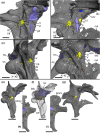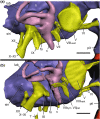Modified skulls but conservative brains? The palaeoneurology and endocranial anatomy of baryonychine dinosaurs (Theropoda: Spinosauridae)
- PMID: 36781174
- PMCID: PMC10184548
- DOI: 10.1111/joa.13837
Modified skulls but conservative brains? The palaeoneurology and endocranial anatomy of baryonychine dinosaurs (Theropoda: Spinosauridae)
Abstract
The digital reconstruction of neurocranial endocasts has elucidated the gross brain structure and potential ecological attributes of many fossil taxa, including Irritator, a spinosaurine spinosaurid from the "mid" Cretaceous (Aptian) of Brazil. With unexceptional hearing capabilities, this taxon was inferred to integrate rapid and controlled pitch-down movements of the head that perhaps aided in the predation of small and agile prey such as fish. However, the neuroanatomy of baryonychine spinosaurids remains to be described, and potentially informs on the condition of early spinosaurids. Using micro-computed tomographic scanning (μCT), we reconstruct the braincase endocasts of Baryonyx walkeri and Ceratosuchops inferodios from the Wealden Supergroup (Lower Cretaceous) of England. We show that the gross endocranial morphology is similar to other non-maniraptoriform theropods, and corroborates previous observations of overall endocranial conservatism amongst more basal theropods. Several differences of unknown taxonomic utility are noted between the pair. Baryonychine neurosensory capabilities include low-frequency hearing and unexceptional olfaction, whilst the differing morphology of the floccular lobe tentatively suggests less developed gaze stabilisation mechanisms relative to spinosaurines. Given the morphological similarities observed with other basal tetanurans, baryonychines likely possessed comparable behavioural sophistication, suggesting that the transition from terrestrial hypercarnivorous ancestors to semi-aquatic "generalists" during the evolution of Spinosauridae did not require substantial modification of the brain and sensory systems.
Keywords: Baryonychinae; Spinosauridae; Theropoda; endocast; palaeoneurology; sensory anatomy.
© 2023 The Authors. Journal of Anatomy published by John Wiley & Sons Ltd on behalf of Anatomical Society.
Figures





References
-
- Allain, R. , Xaisanavong, T. , Richir, P. & Khentavong, B. (2012) The first definitive Asian spinosaurid (Dinosauria: Theropoda) from the early cretaceous of Laos. Naturwissenschaften, 99, 369–377. - PubMed
-
- Allemand, R. , Abdul‐Sater, J. , Macrì, S. , DI‐Poï, N. , Daghfous, G. & Silcox, M.T. (2022) Endocast, brain, and bones: correspondences and spatial relationships in squamates. The Anatomical Record, 1–23. - PubMed
-
- Alonso, A. & Canudo, J.I. (2016) On the spinosaurid theropod teeth from the early Barremian (early cretaceous) Blesa formation (Spain). Historical Biology, 28, 823–834.
-
- Amiot, R. , Buffetaut, E. , Lécuyer, C. , Fernandez, V. , Fourel, F. , Martineau, F. et al. (2009) Oxygen isotope composition of continental vertebrate apatites from Mesozoic formations of Thailand; environmental and ecological significance. Geological Society, London, Special Publications, 315, 271–283.
-
- Amiot, R. , Buffetaut, E. , Lécuyer, C. , Wang, X. , Boudad, L. , Ding, Z. et al. (2010a) Oxygen isotope evidence for semi‐aquatic habits among spinosaurid theropods. Geology, 38, 139–142.
Publication types
MeSH terms
LinkOut - more resources
Full Text Sources

